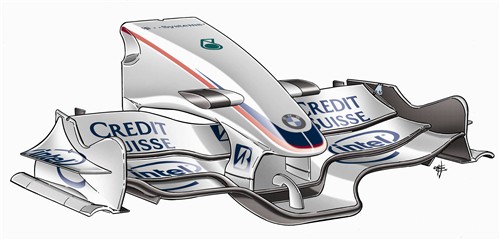Physics
Like many things, physics plays a fundamental
role in Formula One racing. Modern Formula One cars are almost
entirely designed around aerodynamics. The car needs to be as
fast and safe as possible while creating sufficient down force
and minimal drag.
Newtons laws apply to Formula One cars as they do to all large objects in the universe. The three laws as they apply to car racing are summed up nicely by Brian Beckman (The physics of racing):
Down force:
The same principles used for aircraft wings can be applied to the wings found on Formula One cars, but instead of producing lift, down force is produced. Bernoulli's Principle is the physical rule which defines the function of a wing. As air flows at different speeds over the two sides of the wing and at different distances due to the shape of the wing; a pressure difference is created. The pressure tries to balance causing the wing to try and move in the direction of lower pressure.
The following diagram shows lift according to Bernoulli's principle:

Down force according to Bernoulli's principle:

The two wings found on a Formula One car (front and rear) can together produce up to 70% of the total down force on the car. Because of this high percentage, the wings are very important components of the car. Modern wings are intricately designed to maximize their effectiveness. The following is an example of a modern front wing found on a Formula One car.

Drag:
The reduction of drag is very important in Formula One as well. Every feature of the car, including the driver are considered when trying to reduce drag. The drivers helmet, linkages for suspension components, external fixtures and hardware are all designed to reduce drag on the car.
In physics, drag refers to forces which oppose the motion of an object moving with respect to a surrounding fluid.
Drag can be calculated with the following equation:

Where
FD is the drag force
ρ is the density of the fluid
v is the speed of the object relative to the fluid
A is the cross sectional area
CD is the drag coefficient
Newtons laws apply to Formula One cars as they do to all large objects in the universe. The three laws as they apply to car racing are summed up nicely by Brian Beckman (The physics of racing):
"The first law: a car in straight-line motion at a constant speed will keep such motion until acted on by an external force. The only reason a car in neutral will not coast forever is that friction, an external force, gradually slows the car down. Friction comes from the tyres on the ground and the air flowing over the car. The tendency of a car to keep moving the way it is moving is the inertia of the car, and this tendency is concentrated at the CG point.
The second law: When a force is applied to a car, the change in motion is proportional to the force divided by the mass of the car. This law is expressed by the famous equation F = ma, where F is a force, m is the mass of the car, and a is the acceleration, or change in motion, of the car. A larger force causes quicker changes in motion, and a heavier car reacts more slowly to forces. Newton's second law explains why quick cars are powerful and lightweight. The more F and the less m you have, the more a you can get.
The third law: Every force on a car by another object, such as the ground, is matched by an equal and opposite force on the object by the car. When you apply the brakes, you cause the tyres to push forward against the ground, and the ground pushes back. As long as the tyres stay on the car, the ground pushing on them slows the car down."
Down force:
The same principles used for aircraft wings can be applied to the wings found on Formula One cars, but instead of producing lift, down force is produced. Bernoulli's Principle is the physical rule which defines the function of a wing. As air flows at different speeds over the two sides of the wing and at different distances due to the shape of the wing; a pressure difference is created. The pressure tries to balance causing the wing to try and move in the direction of lower pressure.
The following diagram shows lift according to Bernoulli's principle:

Down force according to Bernoulli's principle:

The two wings found on a Formula One car (front and rear) can together produce up to 70% of the total down force on the car. Because of this high percentage, the wings are very important components of the car. Modern wings are intricately designed to maximize their effectiveness. The following is an example of a modern front wing found on a Formula One car.

Drag:
The reduction of drag is very important in Formula One as well. Every feature of the car, including the driver are considered when trying to reduce drag. The drivers helmet, linkages for suspension components, external fixtures and hardware are all designed to reduce drag on the car.
In physics, drag refers to forces which oppose the motion of an object moving with respect to a surrounding fluid.
Drag can be calculated with the following equation:
Where
FD is the drag force
ρ is the density of the fluid
v is the speed of the object relative to the fluid
A is the cross sectional area
CD is the drag coefficient